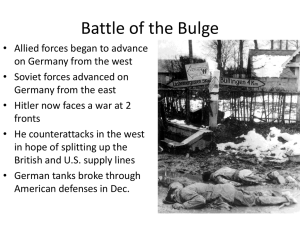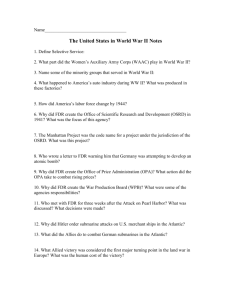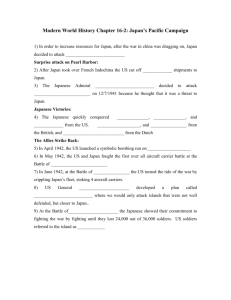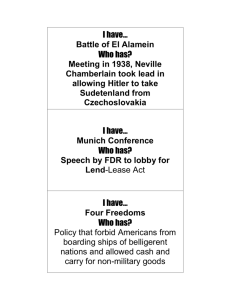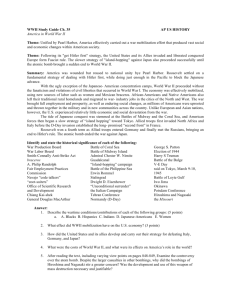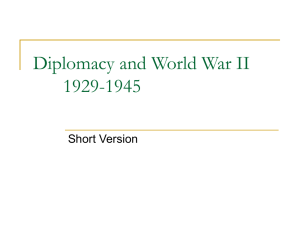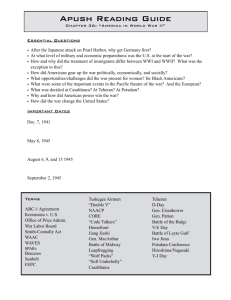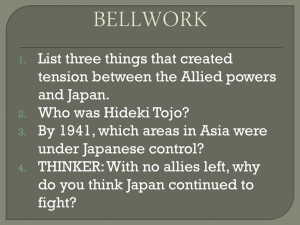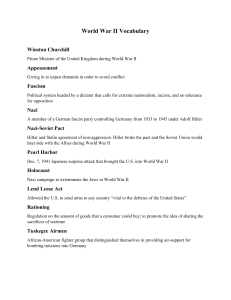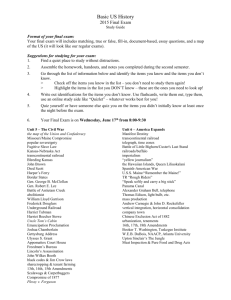Ch. 35 Notes America in WWII
advertisement
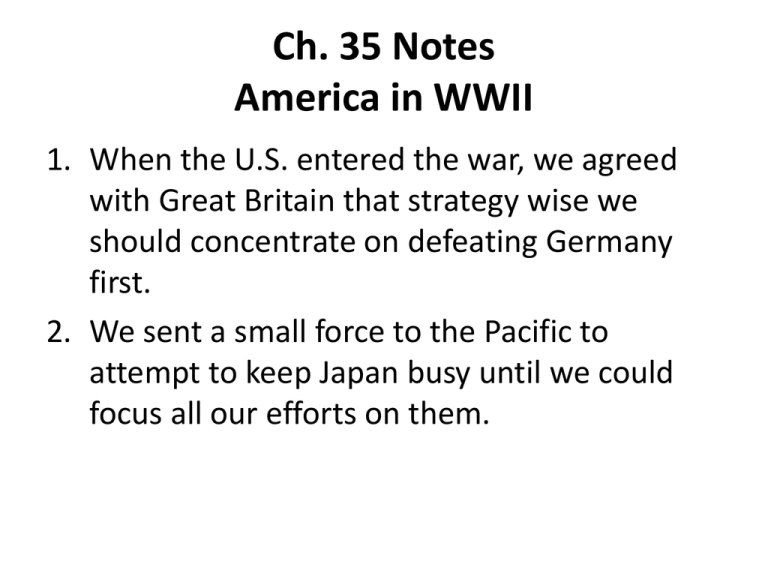
Ch. 35 Notes America in WWII 1. When the U.S. entered the war, we agreed with Great Britain that strategy wise we should concentrate on defeating Germany first. 2. We sent a small force to the Pacific to attempt to keep Japan busy until we could focus all our efforts on them. Participation in the War Effort 1. In contrast to WWI, there was nearly unanimous support for U.S. involvement in WWII because of the bombing of Pearl Harbor, including from immigrants – the war effort actually had the effect of further assimilating immigrants into U.S. society. 2. And even despite discrimination at home, large numbers of minorities joined the military and fought in the war – the military will still be segregated though, so there will be no integrated units, especially with whites and blacks. Tuskegee Airmen 1. The Army Air Corp’s 99th Squadron will be an all African American unit known as the Tuskegee Airmen. 2. They first served in North Africa and never lost a bomber they were assigned to protect. The Wind Talkers 1. During WWII, Native Americans moved off reservations in large numbers seeking employment. 2. 25,000 will serve in the armed forces, many of them as wind talkers. 3. The military used the Comanche and Navajo language as code – the Germans and Japanese could not decipher it. Bracero Program 1. 300,000 Mexican Americans will serve in the armed forces. 2. The U.S. government will also start the Bracero Program, which was an agreement with the Mexican government to bring thousands of Mexican agricultural workers into the U.S. to harvest crops in the west – this program outlived the war. 1. Prejudice and fear against the Japanese in the U.S. led to the interment of over 110,000 JapaneseAmericans – the large majority of them being U.S. born – with Executive Order #9066. 2. In Korematsu v. U.S., the Supreme Court upheld the government’s decision to do so. 3. In 1988 the U.S. government officially apologized for its actions and approved the payment of reparations in the amount of $20,000 to each survivor. Japanese Interment Japanese Interment Camps Women in the War 1. Once again, many women joined the workforce as men went off to war. 2. Over 6 million women worked outside of the home (although a large number of them went back when the war was over citing family obligations) 3. The government established over 3,000 daycare centers to provide for their children as they worked. Women in the Military 1. The armed forces enlisted over 200,000 women. 2. The WAACS (army), WAVES (navy), WASPS (air force) and SPARS (coast guard) used women in non-combat duties. Industry Supports the War 1. The War Production Board took charge of American industry to insure fast, efficient wartime production. 2. The Office of Price Administration controlled inflation by rationing essential goods – inflation was also kept in check by federally imposed wages and price controls. 3. The War Labor Board helped control inflation by imposing ceilings on wages (to keep costs down) Industry Supports the War 1. African Americans 2. 3. 4. Over 1.5 million African Americans left the south to find jobs in the west and north during the war – this led to racial tensions erupting across the country. A Phillip Randolph, the lead of the first all African American union, threatened FDR with a march on Washington to demand equal employment opportunities for African Americans. FDR responded by creating the Fair Employment Practices Commission, which saw to it that no hiring discrimination practices were used against African Americans seeking employment in wartime industries. The Congress of Racial Equality (CORE) was also formed during this time – it will later be an integral part of the civil rights movement. Paying for the War 1. The U.S. debt went from around $49 billion in 1941 to $259 billion by 1945. 2. The estimated cost of the war was over $330 billion – 2/5’s of the cost were paid from current revenues, the rest was borrowed, largely through the sell of bonds. The Battle of the Atlantic 1. After the U.S.’s entry into the war, Hitler was determined to prevent foods and supplies from reaching Great Britain and the Soviet Union. 2. He ordered submarine raids on U.S. ships on the Atlantic – in the first four months they sunk 87 U.S. ships. 3. Over time, the U.S. got better at tracking the Uboats and eventually inflicted huge loses on the German navy. The War in Europe 1. Stalin wanted the U.S. to immediately open up a western front to relieve the pressure on the Soviet Union – we couldn’t do this because Great Britain would bear the brunt of it. 2. In the summer of 1942, the German army took the offensive in southern Soviet Union but were eventually defeated at the Battle of Stalingrad – this will be a huge turning point in the war. 1. Instead of invading western Europe, we set our sights on Northern Africa and Italy first (the soft under-belly of Europe). 2. This proved successful – German general Erwin Rommel (the Desert Fox) will be defeated at the Battle of El Alamein in 1942 – another major turning point in the war. 3. Once we take North Africa, we will invade Sicily. Operation Torch The Invasion of Italy 1. When Sicily is captured, it led to the overthrow of Mussolini and Italy’s surrender. 2. However, the Germans refused to pull out of Italy. 3. Rome was finally captured in June of 1944 – it was the first Axis capital to fall. Operation Overlord 1. In June of 1944, the U.S. finally opened up a western front in Europe. 2. June 6, 1944 (D-Day) Allied forces landed on the beaches of Normandy – it was the largest land-seaair operation in military history. 3. Led by Dwight Eisenhower, the invasion will be successful and Allied troops will begin pushing towards Germany (Paris was liberated by August). Operation Overlord Presidential Election of 1944 1. In 1944, FDR will run against Thomas Dewey. 2. The only real issue for the Democrats was who would be vice president – Henry Wallace was replaced by Harry Truman. 3. FDR easily defeated Dewey, largely because of the success the U.S. was having in the war. 4. However, FDR died on April 12, 1945 – Truman had to finish out the war. Battle of the Bulge 1. By October of 1944, U.S. troops had reached Germany. 2. In a last ditch effort, Hitler launched a major offensive, hoping to break through Allied lines and reach Dunkirk, Belgium. 3. U.S. troops were able to halt the German advance (battle spanned a month) and the Germans took such huge losses that their war was over. 1. The Yalta Conference was the second meeting between FDR, Churchill and Stalin (the first occurred in Tehran, Iran). 2. At the Yalta Conference (Feb. 1945) they agreed that their priority was the unconditional surrender of Germany – they also agreed to the partition of Germany after her defeat. Yalta Conference Germany’s Surrender 1. By March of 1945, U.S. troops had reached Germany’s Rhine River – they discovered and liberated several concentration camps. 2. On April 29, 1945, Hitler and his new bride Eva Braun committed suicide. 3. By May, the German’s had surrendered – May 8, 1945 was designated as VE Day – Victory in Europe Day. 4. Of course, the war wasn’t over because we still had to defeat Japan. Potsdam Conference 1. The Potsdam Conference was attended by Atlee, Truman and Stalin (July – Aug. 1945). 2. At the Potsdam Conference, they finalized their plans for Germany and issued an ultimatum to Japan – surrender or face “complete and utter destruction”. The War in the Pacific 1. U.S. troops in the Pacific were led by General Douglas MacArthur. 2. The strategy they used in the Pacific was known as island hopping – they would bypass the most heavily fortified Japanese outposts and capture nearby islands. 3. They would then build airfields and use their bombers to attack the more heavily fortified Japanese positions. 4. Island hopping proved to be very successful. Battle of the Coral Sea 1. The first naval battle in histroy in which all the fighting was done by carrier-based aircraft was the Battle of the Coral Sea. 2. This battle (May 1942) stopped the Japanese drive towards Australia. Battle of Midway 1. The Japanese then began headed east towards Hawaii. 2. At the Battle of Midway (June 1942), U.S. Admiral Chester Nimitz will defeat the Japanese navy – this will be a turning point in the war in the Pacific because the Japanese will lose four carriers. Battle for Guam 1. In July of 1944 the U.S. will retake Guam – this will be important because from Guam the U.S. can launch bombers against the islands of Japan. 2. The island of Iwo Jima will be captured in February of 1945 – this will give damaged bombers a place to land as they return from Japan. Battle of Okinawa 1. In April of 1945, the U.S. will invade Okinawa – this island is important because it will give the U.S. a jumping off point for a land invasion of Japan. 2. The Japanese will unleash 1900 Kamikaze attacks on U.S. ships (we lose 30) but we will the battle – 7,600 U.S. lives and 110,000 Japanese lives will be lost. Truman Drops the Bomb 1. After Okinawa, MacArthur informs Truman that a Normandy type invasion could result in up to 1.5 million Allied deaths. 2. In Truman’s mind, the only way to prevent this loss of life was to use our new atomic bombs, which had been developed by the Office of Scientific Research and Development as part of the Manhattan Project – we had developed the bomb because we believed Germany might develop one first. 3. On August 6, 1945, we dropped a bomb on Hiroshima and on August 9, 1945, we dropped another on Nagasaki. 4. After the second bomb, Japan agreed to surrender. 5. September 2, 1945, the official day of Japan’s surrender, becomes known as VJ Day, or Victory in Japan Day – we allow Emperor Hirohito to remain as a figurehead but the Allied forces will govern Japan (MacArthur). The Bomb
